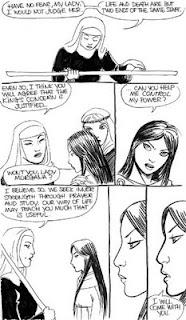It seems like fun to review some Arthuriana from time to time. I have been reading, re-reading and re-watching parts of my collection, and I thought I'd share my impressions with you :). The first item on review is a novel I bought a few months ago.
Idylls of the Queen (1982)
Phyllis Ann Karr
“When Patrise put his head down on the table beside me and started groaning and twitching, my first thought was: and they call me the churl of this court.”That is how Sir Kay starts his tale. Queen Guinevere hosts a dinner party at which one of the guests is murdered with a poisoned apple. The kinsmen of Sir Patrise, the unfortunate victim, accuse the Queen herself of the crime. The lady will be burnt at the stake unless someone proves her innocence by vanquishing Patrise’s kin in a joust. Alas! Sir Lancelot, the Queen’s champion, is away from court! And Sir Kay, the one knight who is free - and willing - to take up her cause, happens to be better at using his wits than at using weapons. So he sets out to unmask the killer by looking for someone with a motive and an opportunity to poison the bowl of fruit.
Idylls of the Queen is a kind of Arthurian detective novel, with the unlikely duo of Sir Kay the Seneschal and Sir Mordred as his sidekick setting off to discover the why and wherefore of the poisoning of Sir Patrise of Ireland. If you have read Malory and/or books based on him, the murder mystery is not especially exciting. The murder of Sir Patrise is an incident in the Morte d’Arthur, and Karr does not deviate from the murderer and motive as revealed there. The exciting part of her book is that she uses the poisoning as a starting-point for an exploration of the Arthurian court, its intrigues and main actors.
As Kay and Mordred, two outsiders, go around questioning knights and ladies, they uncover rather more unsavoury histories than they would have liked - all of them Malory’s, but now seen through the eyes of Phyllis Ann Karr. Karr’s own interpretation and the way in which it twists Malory’s plot (and several conventions of medieval romances) will not perhaps strike those who are unfamiliar with the Morte. But for them, too, the interaction between Kay and Mordred, each with their own reasons for wanting to track down the murderer, is reason enough to read Idylls of the Queen. Malory adepts, however, should consider themselves warned: Karr’s book does not share the Morte’s sympathies. Malory’s favourite knights do not come out looking good, and those Malory does not show in a positive light are the heroes of Idylls of the Queen.
Which brings us to…
Which Gawain?
Name:
Sir Gawaine of Orkney
Looks:
Handsome, broad-shouldered and blond, with an unscathed face despite his having fought many a battle. In his forties and slowly going white.
Presence:
Low. Kay and Mordred send him off to find Lancelot. There is a lot of talk about him, though.
Character:
Absolutely sweet, in a knightly sort of way. Kay reflects that it looks as though Queen Morgause and King Lot spent all the virtues they had to give on their firstborn son, so that unfortunately there weren’t any left for the other three.
Basically, Karr’s Gawain is the opposite of Malory’s. He is very courteous, patient, protective, honourable, honest, modest, unassuming, decent - well, see Kay’s comment about the virtues. In this novel, we get a pre-Malory Gawain in a Malory setting. A particularly delicious characterization of Gawain comes from Mordred: he says his elder brother “believes in Heaven, but not in Hell”.
Rating on the Ampersand Scale of Arthurian Favourites: ****-










